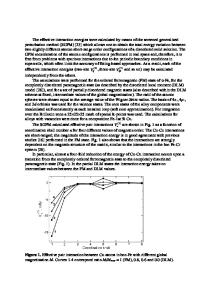Ab initio study of the effect of oxygen vacancy on magnetism in Co doped ZnO
- PDF / 329,193 Bytes
- 6 Pages / 432 x 648 pts Page_size
- 60 Downloads / 360 Views
Ab initio study of the effect of oxygen vacancy on magnetism in Co doped ZnO S. Lardjane1,2, G. Merad2, N. Fenineche1, H.I. Faraoun2 and A. Billard1 1 2
IRTES-LERMPS, UTBM, Site de Montbéliard, 90010-Belfort cedex, France LEPM-URMER, University of Tlemcen, BP 119 13000, Tlemcen, Algeria.
ABSTRACT The effect of oxygen vacancy (VO) on the electronic and magnetic properties of ZnCoO was studied with first principle methods based on density functional theory (DFT). Calculations were performed, on a periodic 3×3×3 wurtzite supercell of ZnO which consists of 108 atoms with two Co ions substituted for two Zn atoms, using the generalized gradient approximation with Hubbard U correction method (GGA+U). We have studied the interatomic exchange interaction with and without VO for different configurations with different magnetic atom lattice arrangements. The total energies, electronic structures and magnetic moments were calculated for each configuration. INTRODUCTION The study of dilute magnetic semiconductors (DMSs) has been a topic of great interest in the past decade since both charge and spin of electrons can be used for novel spintronic devices. DMSs are formed by replacing a very small percentage of cations in a nonmagnetic semiconductor by magnetic transition metal (TM) ions and, therefore, they possess charge and spin degrees of freedom in a single material. Due to the interesting optical and piezoelectric properties of ZnO, the realization of ZnO-based diluted magnetic semiconductors (DMSs) will lead to new technological innovations for multifunctional devices [1,2]. With a high Curie temperature (TC), the ZnO:Co system is promising for applications requiring ferromagnetism above room temperature (RT) [3,4]. Despite a great deal of studies focusing on the Co-doped ZnO, there have been many contradictory reports on its magnetic states. Theoretically, Sato et al. [5] predicted that Co-doped ZnO might be ferromagnetic (FM) without any carrier doping and some other computational results also predicted the existence of high Tc for it [6-8]. Experimentally, Ueda et al. [9] reported ferromagnetic behavior of Co-doped ZnO synthesized by pulsed-laser deposition and with a Tc above 300 K and Janisch et al. [10] showed that magnetic moments of Zn1-xCoxO films grown by various techniques spread over a relatively wide range from 0.56 to 2.6 μB/Co. However, other reports claimed no trace of ferromagnetism in these systems [11,12]. Defects (O vacancy (VO), Zn vacancy (VZn), Zn interstitial (Zni), n-type doping, p-type doping) were suggested to induce a high temperature ferromagnetism. Also, Seghier et al. [13] have suggested that the oxygen vacancy (Vo) is likely to be a main mediator for the ferromagnetism in the Codoped ZnO. Therefore, it is necessary to investigate the effect of VO on the magnetic properties of Co-doped ZnO. In this paper, using a first principle method, we report the effect of VO on the electronic structure and the magnetic coupling of Co-doped ZnO.
31
COMPUTATIONAL DETAILS First principle calculations hav
Data Loading...











